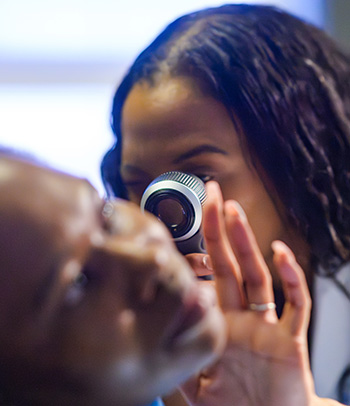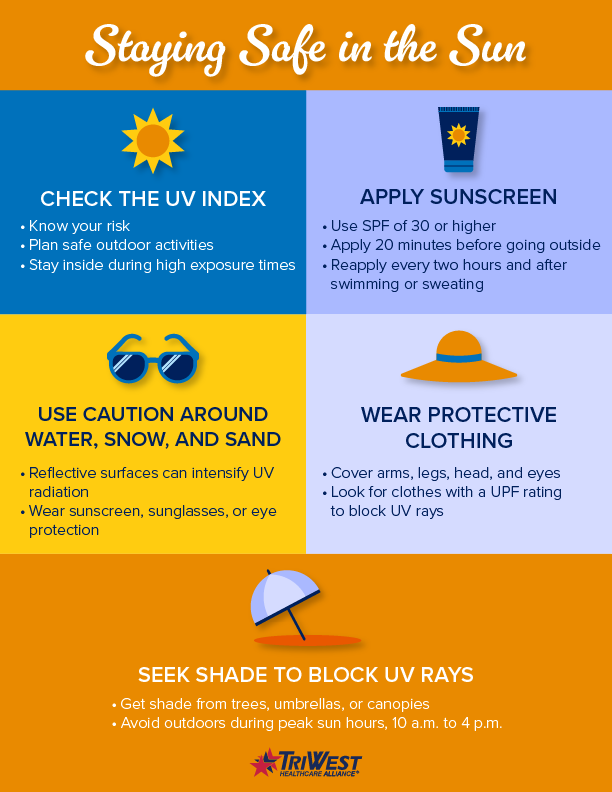By understanding the risks of sun exposure and implementing sun safety practices, you can enjoy the rest of summer while protecting your health.
The impact of a warming climate has made sun safety more important than ever. According to the National Oceanic and Atmospheric Administration (NOAA), this year is expected to rank in the top five warmest on record, with hotter than average temperatures for much of the U.S. and higher than average Ultraviolet (UV) Indexes.
This means you need to be extra vigilant about sun protection. August is Summer Sun Safety Month, a reminder to keep your skin safe and healthy while enjoying the outdoors.
Beyond the Heat: Why Checking the UV Index is Key to Sun Safety
Temperature and the UV Index are two key factors to consider before you spend time outdoors. While related, temperature and UV Index are not the same. For example, a hot day doesn’t always mean a high UV Index, and a cool day doesn’t necessarily mean a low one.
The UV Index is a numbered scale that ranges from 0-11+ and measures the strength of the sun’s rays. A higher number indicates more intense rays. When you are exposed to high UV, you have an increased risk of skin burns, eye damage, and cancer.
It’s important to learn how to read the UV Index Scale to help you avoid harmful exposure to UV radiation. Whether you’re working in the garden, at the beach, or just taking a walk, the UV Index Scale is there to guide you:
- 1-2: Low. At this level, the sun’s rays are gentle. No protection needed. You can safely stay outside using minimal sun protection.
- 3-7: Moderate to High. The sun is getting stronger. Protection needed. Use sunscreen with at least 30 SPF and wear protective clothing with a hat and sunglasses.
- 8-10: Very High. The sun’s rays are very strong. Extra protection needed. Be careful outside, especially during the hottest part of the day between 10 a.m. and 4 p.m. Seek shade. Use sunscreen, protective clothing, and accessories.
- 11+ Extreme. This is when the sun is most intense. It is best to stay out of the sun if you can, especially during the hottest part of the day.
The U.S. Environmental Protection Agency (EPA) will send out a UV alert when the sun’s UV radiation is expected to be higher than normal. If one has been issued for your area, the alert will accompany EPA’s UV Index forecast.
You can sign up to receive emails with your area’s UV Index forecast. You can also find UV Index forecasts by ZIP Code.
A Sun-Kissed Glow: Concerns Over UV Index Tanning Trend
Even with increased awareness about the dangers of sun exposure, some Americans still associate a tan with health and beauty. An emerging trend among young people is to use the UV Index to find the best time to tan.
Tracking the UV Index and glorifying tan lines has become part of the social media culture for Gen Z (age 13-28). With many Americans living in areas with increasingly high levels of UV radiation, this is a concern of the EPA. The cause of most skin cancer is overexposure to UV light, with sunburns at a young age significantly increasing the lifetime risk of developing skin cancer.
Gen Z’s pursuit of a tan, especially by intentionally exposing themselves to high UV levels, has raised alarms among dermatologists and health professionals.
Teaching people, especially children and teenagers, about these risks and encouraging protective behaviors can greatly reduce their chances of developing skin cancer later in life. Additionally—and especially important to many young adults—UV exposure can accelerate skin aging, causing wrinkles, fine lines, and age spots.
It’s still important to get outdoors, as it has many physical and mental health benefits, such as improving mood, boosting vitamin D levels, and encouraging physical activity. The key is to do it strategically. Referring to the UV Index to plan your time in the sun is a great step.
Skin Cancer Warning Signs: Spot It Early with Total Body Skin Checks
New reports from the American Cancer Society indicate that skin cancers are on the rise in 2025, including over 212,000 melanoma cases. Melanoma is the deadliest form of skin cancer, with an expected 8,430 deaths in 2025.
U.S. Veterans are at a higher risk of developing skin cancer than the general population, and melanoma diagnoses are also rising among active-duty Service members. This is due to several factors, including prolonged sun exposure and lack of sun protection.
Self-Exams Help Detect Skin Cancer
When skin cancer is found and treated early, it is often curable. As it progresses, it becomes harder to treat. This is why skin checks are so important. Regular self-exams are recommended, even for those with low risk:
- Check skin monthly to look for skin abnormalities. Look for bumps or sores that don’t heal. Look for moles that have changed size, color, or shape. Also, be aware of any spots that are itchy, tender, or painful.
- Have a friend or family member check your back and scalp.
- Don’t forget to check areas that are not often exposed to the sun, such as the soles of your feet and underarms.
- Visit your dermatologist to have any skin abnormalities evaluated.
When doing a self-exam, it’s important to check all areas of the body. This includes the scalp, face, neck, trunk, arms, hands (including between fingers and under nails), legs, feet (including soles and between toes), and the genital and buttock regions. Using both a full-length and hand-held mirror can help you see hard-to-reach areas. During self-examination, look for the “ABCDE” features of melanoma:
- Asymmetry: One half of the mole doesn’t match the other.
- Border: Irregular, scalloped, or poorly defined edges.
- Color: Varied shades of brown, tan, or black, and sometimes red, white, or blue.
- Diameter: Greater than 6 mm (about the size of a pencil eraser)
- Evolution: Changes in size, shape, or color over time.
If you have a high risk of skin cancer due to fair skin, light eyes, red or blonde hair, a history of sunburns, use of tanning beds, family history of melanoma or skin cancer, or numerous moles, check with your doctor about the frequency of professional skin exams. Many dermatologists recommend yearly professional skin exams if you are considered high risk.
The good news is that overexposure to UV radiation is the most preventable cause of skin cancer. By understanding the risks of sun exposure and implementing sun safety practices, you can enjoy the rest of summer while protecting your health. Don’t be afraid, just be informed!







